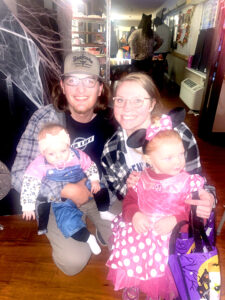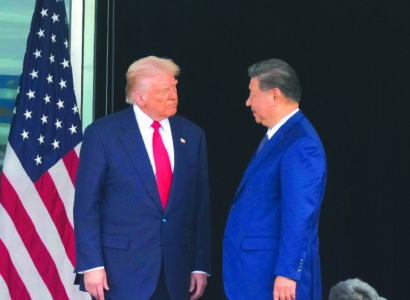Juniata Terrace celebrates 100 years

Sentinel photo by SIERRA BOLGER
Local officials gathered Thursday to celebrate the 100th anniversary of the groundbreaking at Juniata Terrace. From left, Fred McMillin, councilman; Cindy Berrier, former resident; Steve Wilson, owner of Wilson’s Meats and Groceries; Leo Dukes, resident; Rick Bodenschatz, historian; Ruth Jones, resident; Sandy Zimmerman, resident; Doug Kepnar, council vice president; Heidi Traxler, councilwoman; Eric Rhodes, council president; Caitlin Noland, borough manager; John Wagner, mayor.
LEWISTOWN — Residents gathered Thursday morning to celebrate the 100th anniversary of the groundbreaking at Juniata Terrace.
The event was attended by representatives from state Rep. Kerry Benninghoff and Sen. Judy Ward’s office, who presented members of Juniata Terrace borough council with a citation — congratulating the Terrace on its 100th anniversary.
To commemorate the occasion, local officials and residents gathered again to break ground at the Terrace.
During the ceremony, Juniata Terrace Mayor John Wagner spoke on the history of the community.
He explained that the Courtauld Company of Essex, England, obtained the patent for viscose-based artificial silk in 1904, setting up their first factory in 1905 in Coventry, England. In the years that followed Courtauld recognized business opportunities in America, and by 1919, American Viscose built its third factory in Lewistown, employing almost 5,000 workers. As employment grew and more workers moved to Lewistown, more housing was needed.
In May 1922, Viscose announced they would build a “large industrial village” for the workers of the plant on the 150-acre farm owned by Dr. Henry Sweigart, of Lewistown.
Wagner said Sweigart gave the Juniata Terrace its name. He leased the farm to Bill Shade and his family, who continued to farm the remaining 80 acres and Shade remained there until he passed away in 1973.
Eric Rhodes, president of the Juniata Terrace borough council, also discussed the history of the Terrace.
He said Emile Perrot, of Philadelphia, was the chief architect and Ballinger Co. was the infrastructure engineer and construction manager. The Harry Brocklehurst Co of Philadelphia was hired as the general contractor.
On Saturday, June 23, 1923, their staff and workers arrived by train from Philadelphia with all of their equipment. A side rail delivered the train from the main line of the Pennsylvania Railroad, up the hill, past the new sewage disposal plant site, past Shade’s barn to First Street at Granville Road by what now is known as Delaware Avenue.
Rhodes said the big cut for the Terrace was excavated through the farm, pushing the dirt to make room for the school, playground and 11 blocks of homes. An assembly line process was used to complete the homes. The first home was occupied in 1924 and the last was in 1925. Sidewalks and boulevards were completed in 1926 and the first classes were held at the elementary school in September, 1928.
These homes could only be rented by employees for $1 a week, which was deducted from their paychecks. By 1944, weekly rent increased to $4.60 and there was a large waiting list. In addition to large families, extended families and boarders, sometimes up to 13 people occupied the house. In the 1930 census, Juniata Terrace had 1,728 residents with 610 of those working for American Viscose. In perspective, the 2020 census reported 567 residents.
Wagner continued, “At the beginning of WWII, Great Britain was forced to sell American Viscose to an American stock group to raise money for their war effort.” Although this had no impact on the Juniata Terrace, many residents joined the military during WWII. Some traveled to Harrisburg and Altoona to work in war industries. Many men and women continued to work at the Viscose, which he said contributed significantly to the war effort.
“Ten residents made the ultimate sacrifice, giving their lives for our freedom,” Wagner said.
“During the Korean conflict another resident was lost in battle. These 11 heroes are honored on our memorial located at Terrace Boulevard and First Streets,” Wagner said. “Juniata Terrace has a long history of residents serving our country through the years of war, conflict and peacetime. We are proud that our residents love our country.”
Rhodes continued, explaining that American Viscose was sold to Monsanto in 1949, who had no desire to own and maintain employee housing. By 1950, all 250 homes were sold individually for price tags between $2,300 to $3,000. In 1951, the two stores were sold to the Staffords for $25,000. The school was owned by the Lewistown School District.
In 1952 the Christian, Missionary and Alliance Church was built.
Rhodes said, “The church has been a wonderful neighbor, being supportive of our community and providing worship, Sunday school, Bible school, weddings, funerals and other vital contributions of faith and community.”
As part of the sale, the Juniata Terrace Civic Association was created by American Viscose to oversee services for the community. These services include operation of the sewage plant and maintenance of the streets, such as snow removal. “This group did so much more.”
The Borough of Juniata Terrace was born Jan. 1, 1967, electing a mayor and council members.
“The residents have always been a family. A good example of this is when the 2014 fire gutted 11 homes and damaged 14 others. Neighbors pitched in to help, past residents came back, even from out of town, to see what could be done,” Rhodes said. “Don’t ever doubt the residents of Juniata Terrace.” In less than 2 years, the 25 homes were rebuilt.
The service ended with a prayer by Pete Weaver and refreshments, also allowing other residents to shovel.
Afterwards, all stepped outside to commemorate the occasion by breaking ground again. Helen Walsh Ballinger, representative for Walter Ballinger, shoveled first. Following her was Rick Bodenschatz, representative for Emile Perrot. Next, Fred McMillin shoveled for Samuel Courauld, founder of the American Viscose company. Doug Kepner represented William Stainton, who was the general manager of the American Viscose company. Residents were then allowed to shovel, including Ruth Jones, Sandy Zimmerman, and Leo Dukes, whose family housed 11 people. Steve Wilson of Wilson’s Meats & Groceries was the last to shovel.



